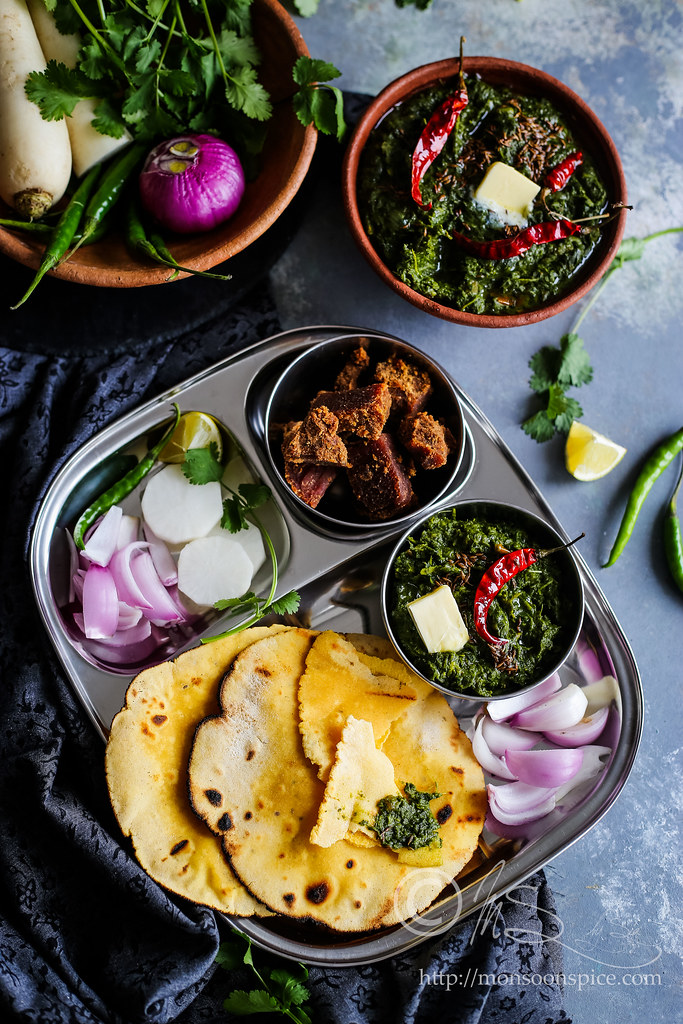
The temperature outside is steadily rising and the latest weather forecast says that it will touch 18 deg C this weekend! The delicate snowdrops and colourful crocus are blooming everywhere and the daffodils are almost ready to spread their sunshiny cheer! It feels like the winter is at its teetering end in my neck of woods.
In the last 13 years of winters in the UK, this year has been the mildest and short winter ever. Last year, we were still buried under the blanket of snow until April, and this year I have seen more sunny days than in winter than all the winters in the last decade put together! Talk about global warming!
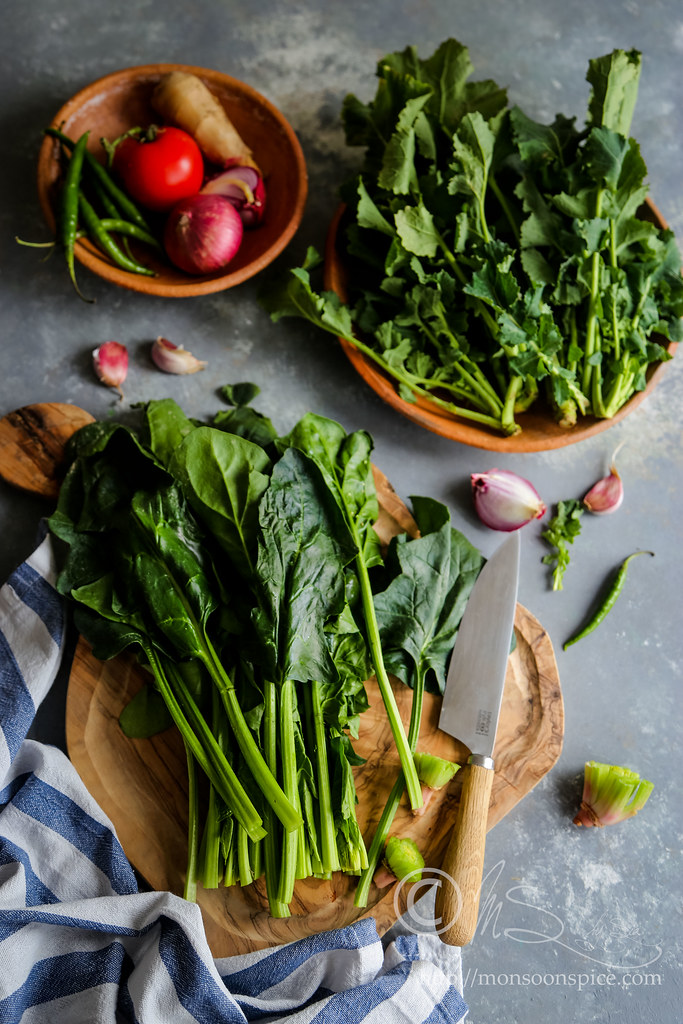
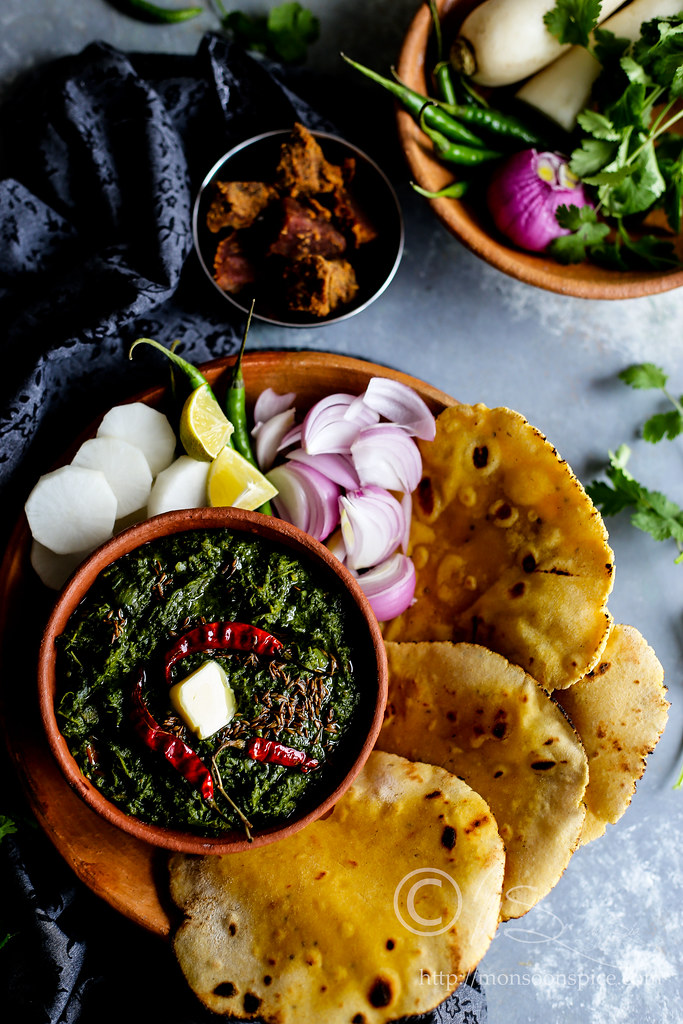
Before we bid adios to winter and winter produces, especially winter greens, I am making the most of them by cooking all my winter favourite dishes from India. The ingredients you see here are used in making one of my most favourite winter dish from the land of 5 rivers. It’s Sarson ka Saag or in simple words, mashed mustard and winter greens. Saag is a generic name for cooked and pureed green leafy vegetables like mustard greens, spinach, fenugreek leaves, kale, spring greens, coriander and even mint leaves! Unlike spinach greens, which takes just few minutes to wilt and cook, saag takes much longer time as the greens usually have thick leaves and veins which take long time to break when cooking. I don’t call myself a patient cook, but once in a while when there is a special occasions like my loved one’s birthday, I pour my energy and every bit of me into making something special to celebrate the special days of my loved ones. Like every year, I cook something new which they have never tried before for birthday dinner and this year for my husband’s birthday I cooked this classic combination of Sarson ka Saag and Makki ki Roti.
Sarson ka Saag is not a dish that you can rush into making. It needs patience, time, love and care, much like basking in mother’s love. May be that’s the reason why I call this as mother-food as it is the enormous love she pours into cooking it that gives it a distinct taste. When I told my Punjabi friend about what I was planning to cook for hubby’s birthday, she warned me that it is no good writing about the iconic combination without mentioning the healthy helpings of ghee and butter that go into the dish. and served hot with a blob of homemade butter, some jaggery and perhaps a salad of radishes or onions. The butter, ghee and jaggery, my friend assure me, are a must to help with the digestion.
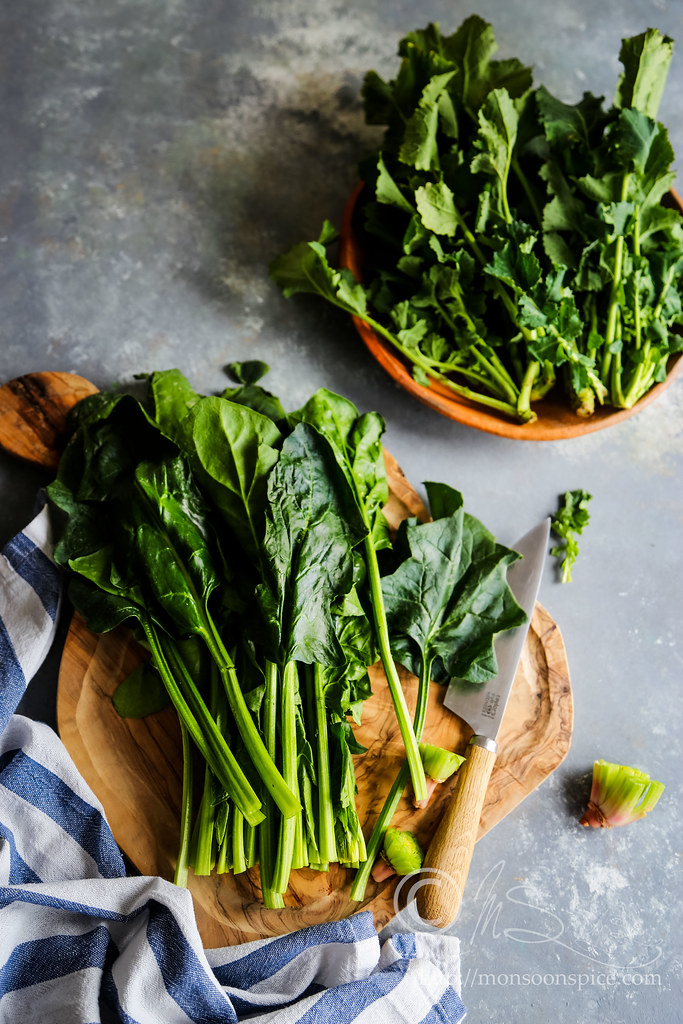
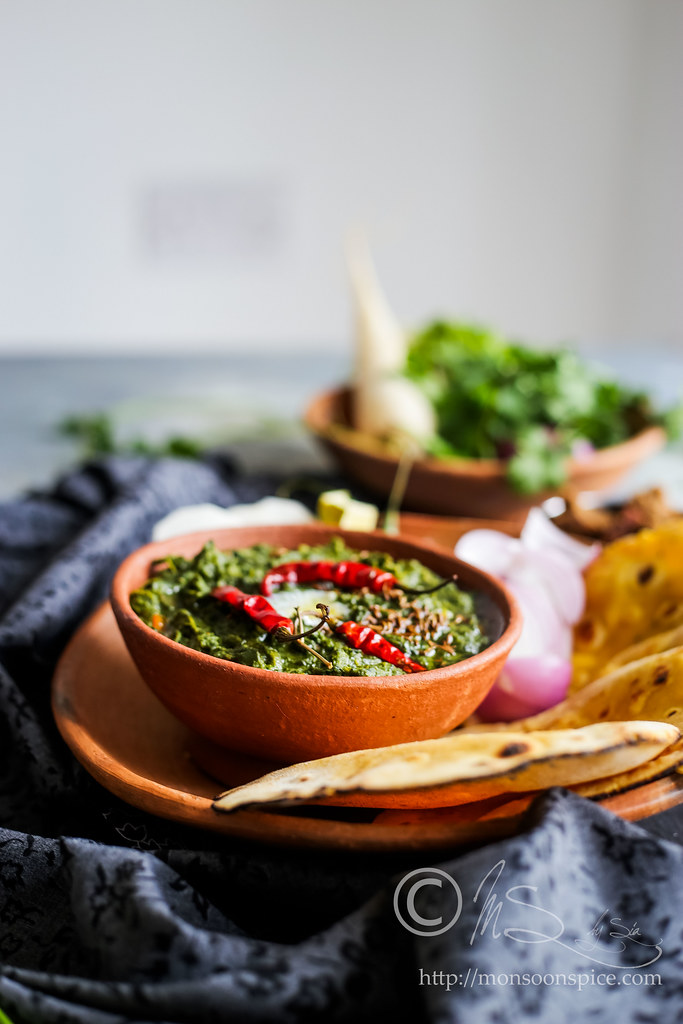
I listened to her, and the result is here for all of you to feast upon, a product of so much love, care and passion! It takes time and tests your patience as you pick the leaves, discarding weeds, shaking out the mud and then washing the leaves 3-4 times before cutting and cooking them. Some jeera and hing in hot oil, followed by chopped garlic or onions with ginger and green chilli paste, and if you are a not purist, then perhaps few finely chopped tomatoes too cooked until soft. A sprinkling of turmeric and red chilli powder before the cooked and mashed saag and makkai ka atta goes in along with some salt. You let it simmer and slow cook for all the flavour to blend and mature before finally adding a handful of cilantro for that freshness and then a generous helping of ghee and/or butter as your taste and waist demaids. And no, you just can NOT add cream or cashew nut paste into it.
My friend shared her fond memories of making this saag by her mother and aunts who would start the prep work a day before for making the creamy delicious Saag which was cooked on open wood fire. By early morning, the household would wake up to the heavenly aroma of Saag gently bubbling over slow fire to which the lady of the house would stir in a dollop of buttur and love to be packed away in tall Tiffin boxes for the men of the family who needed all the nourishments and love to work in a large farm during cold winter days. I could just sit there sigh thinking about the taste of Saag, which was slow cooked overnight, a product of so much love, care and passion! A true labour of love shining through simple, homemade dish!
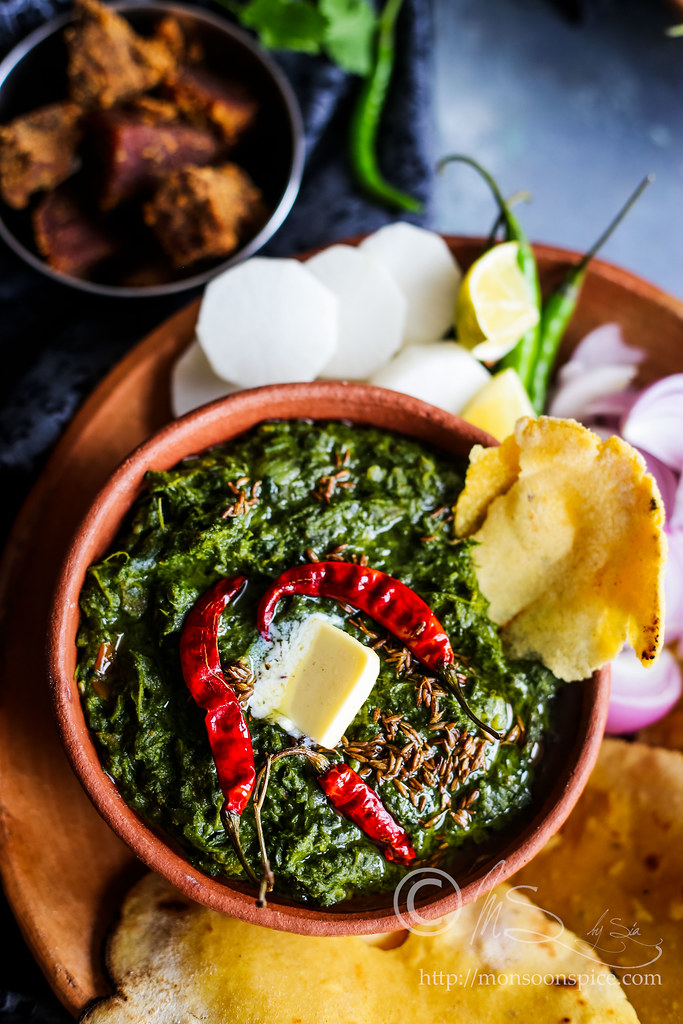
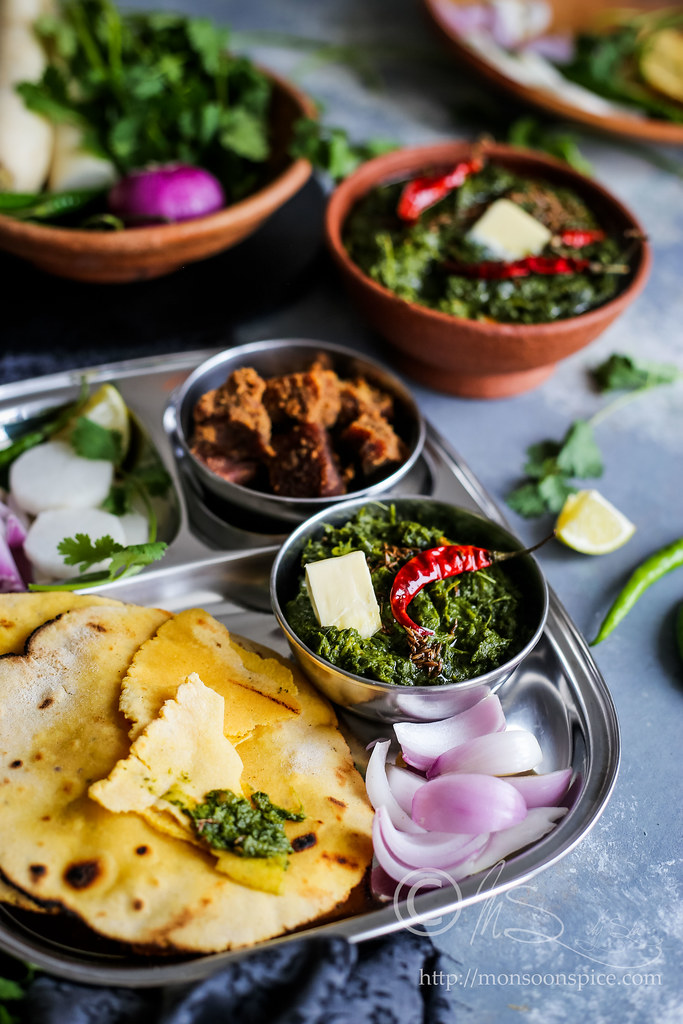
For the Makki ki Roti, my friend stressed on to remember just one thing; the roti is ‘always’ slathered with generous amount of ghee. The makkai flour (fine cornmeal) with ajwain (carom seeds) is kept in a large paraat and small portions of it, kneaded into a dough with warm water. The dough can’t all be made at one go as it will dry up, making it difficult to pat into rotis. The roti is patted into shape directly on the griddle with one’s bare hands, a knack developed after years of practice and patience. It is served hot with a blob of homemade butter, saag, some jaggery and perhaps a salad of radishes, green chilli and/or onions.
The taste of mustard greens in Saag is an acquired taste and not everyone will like the pungent and slightly bitter taste of mustard greens. The addition of spinach and fats like ghee and butter mellows the bitterness of mustard green little bit. A decade ago when I tried the Sarson ka Saag recipe for the first time, honestly, it didn’t make my heart sing its praise. And today, I just can’t seem to get enough of it and have been cooking it every fortnight enough to last for at least 3-4 meals. I personally love the taste of leftover Sarson ka Saag where the flavours have matured. If I have to describe the taste of Sarson ka Saag, it is like the smell of earth after the first rain; a pleasant earthy smell with a delicious herby flavour that has enslaved my taste buds and the taste of it, my friends, lingers in your mind and soul for very long time!
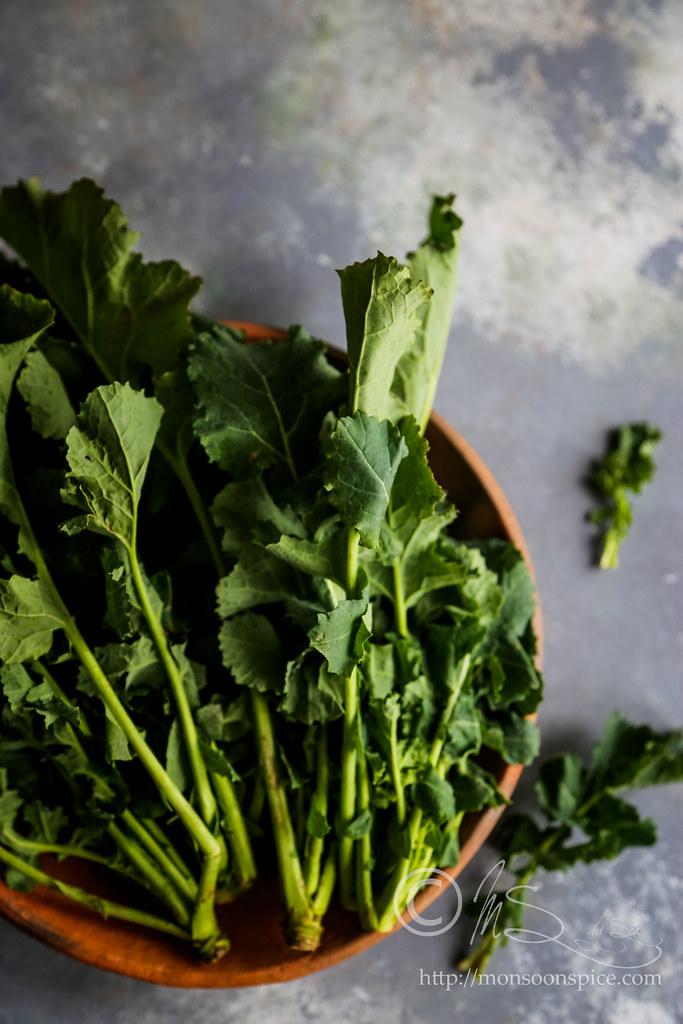
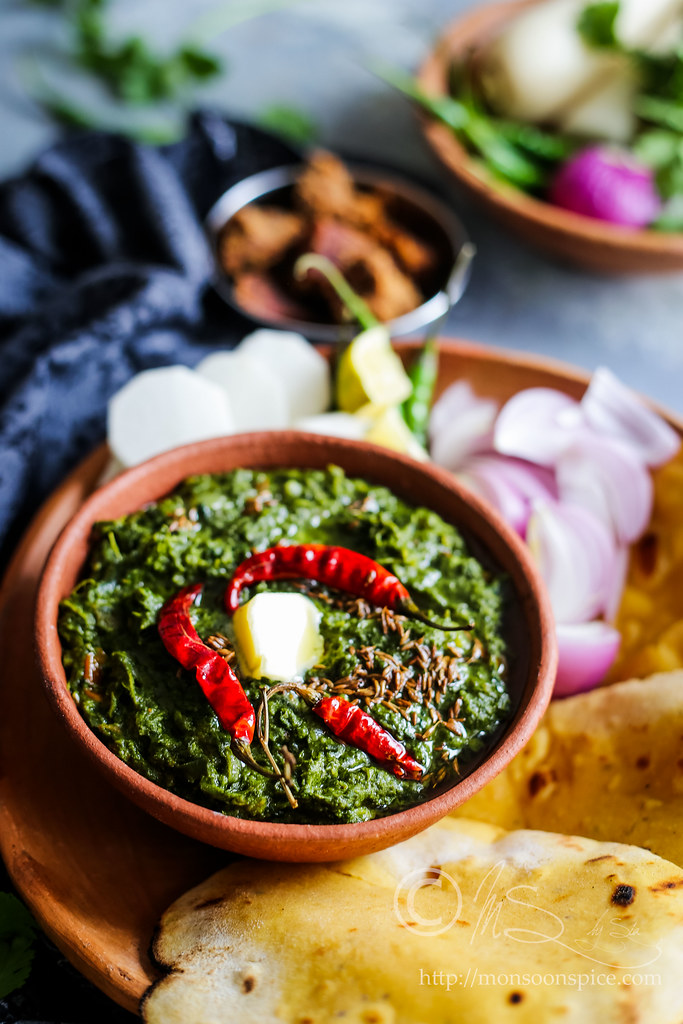
Sarson ka Saag (Mashed mustard green and spinach curry)
Prep Time: 15-20 mins
Cooking Time: 30-40 mins
Recipe Level: Easy/Beginner
Spice Level: Low to Medium
Shelf Life: 4-5 days when refrigerated
Serving Suggestion: With Makkai ki Roti or with rotis
Ingredients:
3 bunches (approx. 500 gms) Mustard Greens
2 bunches (approx. 250 gms) Spinach
2 medium Onions, peeled and finely chopped
2 medium Tomatoes, finely chopped
2 inch Ginger, peeled and roughly chopped
3-4 large cloves of Garlic, peeled and roughly chopped
1-3 Green Chillies, finely chopped (Adjust as per taste)
¼ cup Makkai ka Atta/Maize
2 - 4 tbsp Butter (Adjust as per taste)
Spices Used:
1 tsp Haldi/Turmeric Powder
1-1½ tsp Red Chilli Powder (Adjust as per taste)
For Tadka:
1 heaped tsp Jeera/Cumin Seeds
2-3 Dried Red Chillies
¼ tsp Hing/Asafoetida
2 tbsp Oil
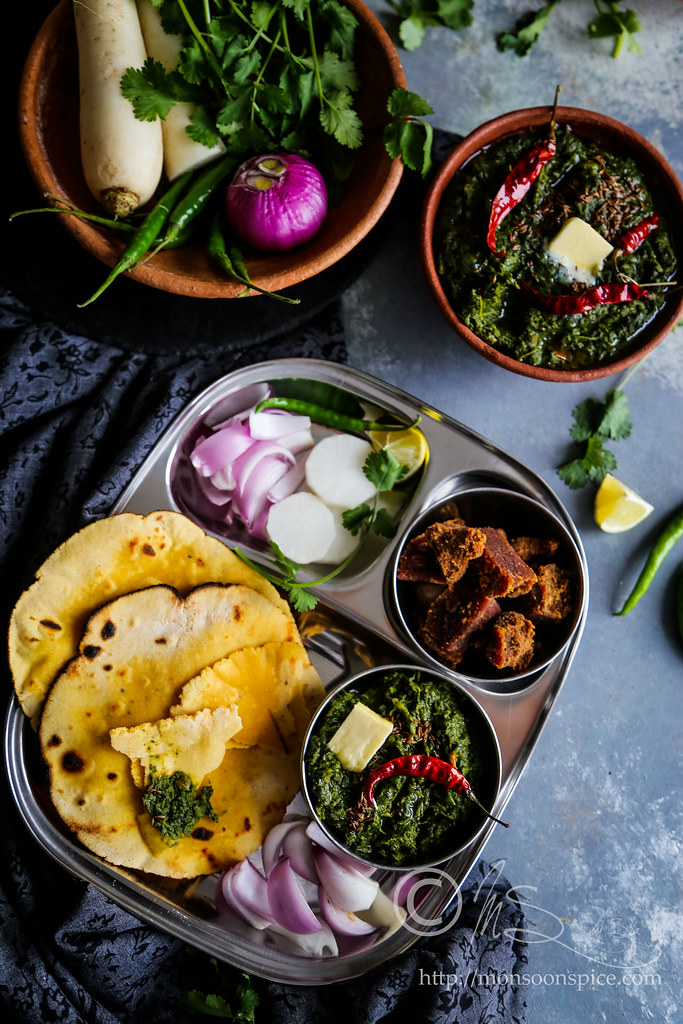
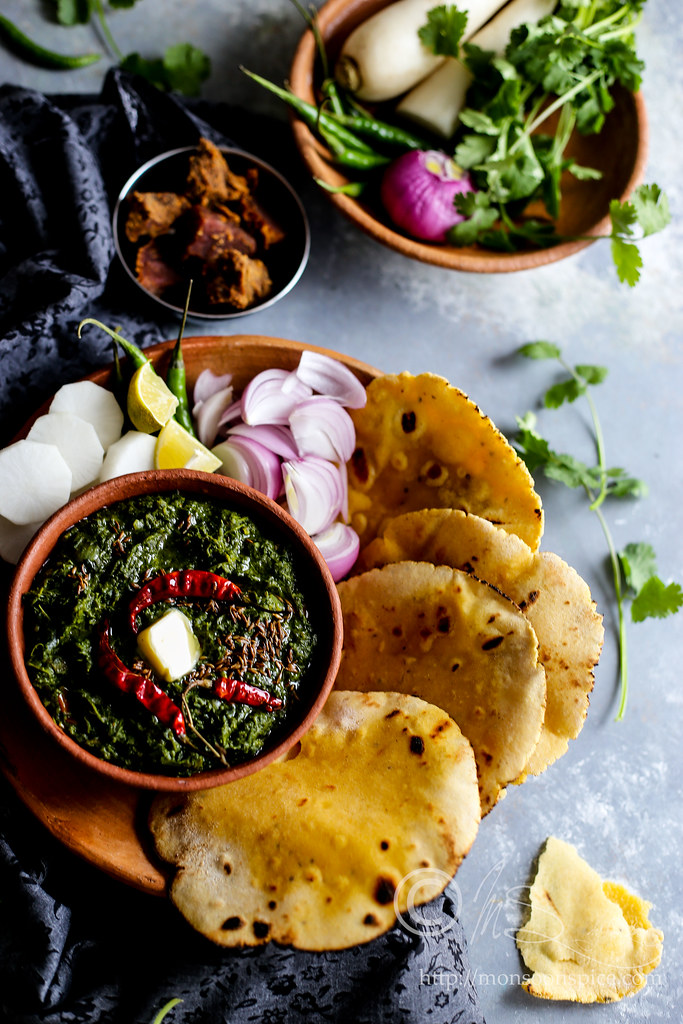
Method:
Preparation:
- Pick the mustard greens leaves and discard the tough stems. Place it in a large bowl and fill it with water. Rub and wash the leaves to remove any dirt stuck to the leaves. I recommend washing it 3-4 times until the water turns clean without any soil. Similarly, wash the spinach greens with stems until they are free of any dirt or soil attached to them.
- Take a large handful of mustard greens and roll them into tight bundle. With a help if a sharp knife, chop them roughly and transfer into a large sauce pan.
- Similarly, chop the spinach leaves with stems and keep them aside in a bowl until needed.
- Peel and finely chop the onions. Finely chop the tomatoes and coriander leaves keep them aside until needed.
- Peel and roughly chop ginger and garlic. Remove the stem and finely chop the green chillies. Place them all in a mortar or a spice grinder and grind them or pound them with a pestle into a paste.
Proceed to Cook:
- Place mustard greens in a pan large enough to hold all the greens. Add 1 cup of water and cover and cook for 5-7 minutes on medium flame. Open the lid and mix them all well in between to make sure that all the greens are cooked. Mustard greens take longer time to cook and hence we are cooking this first before adding the spinach.
- Once the mustard greens wilt and reduce to ¼ th of volume, add the spinach and let it cook for 4-5 mins. Turn off the flame and let the greens cools down.
- While the greens are cooling, Heat 1 tbsp of oil in a pan and add maize or fine cornmeal. Roast the flour on low to medium heat until it turns fragrant and changes colour, about 2-3 mins. Transfer it to clean and dry bowl. This is an optional step, but I recommend it as it helps in speeding up the cooking process.
- To prepare the masala for Saag, heat 1 tbsp of oil and 1 tbsp butter in a pan and add cumin seeds, dry red chillies and hing.
- When the cumin seeds sizzle and change colour, add finely chopped onions and sauté on medium flame for about 2 minutes or until they soften.
- Add the ginger-garlic-green chilli paste and stir them for about 2 mins or until the raw smell disappears.
- Add turmeric and red chilli powder and give it a quick mix before adding finely chopped tomatoes. Cook the tomatoes for 2-3 minutes or until they turn soft and release their juice.
- While the tomatoes are cooking, transfer the cooked greens into a food processor or a blender and grind them to smooth or coarse paste. I personally prefer a coarse puree to the smooth one.
- Transfer the pureed greens into the pan and sprinkle salt to taste and about 1- 1½ cups of water. Mix them all well and cover the pan and let it cook for 5-6 minutes.
- Next add the roasted corn meal and mix them all well. Taste and adjust the seasonings at this stage and also add some more water if you find the saag too thick to get the desired consistency. Cover and let it simmer for 5-10 minutes.
- Finally, swirl in the remaining butter and mix them well. Mix in finely chopped coriander leaves and turn off the flame. Cover and let the saag rest for at least half an hour for all the flavours to blend well.
- When you are ready to serve, heat the Sarson ka Saag and serve it topped with a knob of butter with some ghee smeared makki ki roti, a salad of sliced onions and radish with a wedge of lime and of course, some jaggery for a wholesome meal. Enjoy!
Sia’s Notes:
- You can cook the greens in a pressure cooker to speed up the cooking process. Just add the greens in a pressure cooker along with a cup of water. Close the lid and cook for one whistle. Let the pressure release before opening the lid and follow the recipe instruction above.
- Roasting the maize or cornmeal is an optional step, but I recommend it as it helps in speeding up the cooking process.
- I haven’t used any other spices other than turmeric and red chilli powder as I prefer the Saag to have herby flavour and I didn’t want this flavour to be masked by strong spices. But if you want to add layers of spice flavours, you can go ahead and use a tsp of coriander powder, roasted cumin powder and even some garam masala.

Thanks for the great recipe.
ReplyDelete